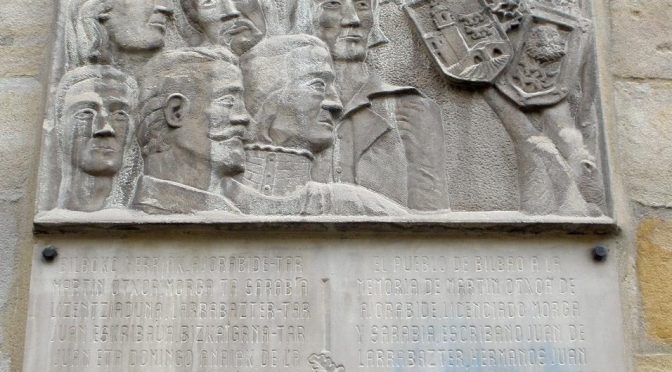The 1800s was a time of great upheaval in the Basque Country, embodied by the Carlist Wars. These grew out of the widening gap between the rich and powerful and the common people, developing over centuries, who were being lost in the globalization and unification of markets. Prices soared as speculators inserted themselves in markets. Traditional Basque privileges were abolished or curtailed as the Crown tried to homogenize the country. Rural regions saw themselves subservient to the richer cities. All of these led to an unstable situation that repeatedly broke into riots across Bizkaia and Gipuzkoa.

- The word matxinada (machinada in Spanish) comes from machín, a local name for Saint Martin by which iron workers were known. It eventually became associated with conflict, more specifically riots that the working and peasant classes held against the ruling class. Many factors contributed to the general dissatisfaction that led to these riots, but at the heart was the worsening conditions of the peasantry as Spain tried to centralize and unify. Consumers lost power of supply and demand, seized instead by speculators. This led to harsh conditions, high food prices, and discontentment.
- There were five major matxinadas in the Basque Country. The first, the Salt Matxinada, took place between 1631 and 1634 in Bizkaia. It arose from several factors, including the disenfranchisement of the common people in the political process and the imposition by Castilla that all subjects, including those in the Basque Country, had to help defend the empire. This included new taxes. At a time when harvests were poor, this led to higher food prices. The government imposed even more taxes on and prohibitions in the buying and selling of salt, a critical commodity used throughout the economy. In October, 1632, the people revolted, killing at least one representative of the government. Amongst the many demands of the revolters was the abolishment of the prohibition of the sale of salt, which the Crown ultimately did in April, 1634.
- The Customs Matxinada happened in 1718. In 1717, in an effort to regain the territories it had lost in the Treaty of Utrecht, the Bourbons tried to impose reforms to the tax system and moving customs offices to the coast. Before this, products produced or imported into the Basque provinces were free of most taxes, until they were introduced into Castilla. The reforms of 1717 tried to change this. Again, these changes harmed consumers and threatened the political system of the region. In March, 1718, when the customs moved, the people, primarily in Bizkaia and Gipuzkoa, revolted. A tax collector was killed and multiple customs boats were burned. Several government leaders, including the mayor of Bilbo, were also killed. The more powerful raised their own army against the revolters and called on the king to intervene. The whole situation led to a split in Basque society about the role of the fueros, as the merchant class benefited from the changes in customs.
- 1755 saw the Meat Matxinada. Economic speculation was rampant, including in meat. Beef exports from Bizkaia and Gipuzkoa to other provinces in Spain were particularly important to the economy. Gipuzkoa tried to regulate the selling of beef to reduce speculation, but the peasants that actually raised the animals benefited from the practice. The government of Gipuzkoa went so far as to ban the export of beef and force the animal owners to sell in local markets. Other restrictions were also put in place, all of which harmed the producer. Towns began to rise up, but the rulers quickly responded with a militia that met little resistance, quelling the matxinada. However, nothing was resolved.
- Cereals were next. In 1766, the Cereal Matxinada hit Bizkaia and Gipuzkoa. A number of factors led to these riots, but one important factor was the reduced ownership of land – land wealth was concentrated in fewer and fewer hands. Most peasants had become tenants, without land of their own. Further, some 80% of their income went to taxes and rent. Cereal prices increased due to poor harvests, inflation and speculation, and changes in tax code. In particular, speculation was rampant after a decree in 1765 that abolished taxes on cereals. Speculation hurt consumers, leading to famine. The matxinada was sparked by the exportation of cereals by speculators in Gipuzkoa to Nafarroa, Asturias, and Galicia. Starting in Gipuzkoa, it spread to Bizkaia. Amongst the demands were price controls in cereals and meats, the use of communal lands, and the participation of common people in government. While no one was killed in the riots, there was significant property damage. However, having learned from previous matxinadas, the ruling class quickly quelled this one as well and in the end few of the demands were enacted.
- The last great matxinada was the Zamacolada of 1804, in Bizkaia. The conflict between the ruling class and the common people was ever deepening. In an effort to weaken the power of Bilbo, multiple proposals to build a competing port were advanced, including one by Simón Bernardo de Zamacola. At the same time, the rulers of Bilbo schemed to harm the new project. Eventually, several towns rioted, capturing government officials and forcing them to hold new meetings.
Primary sources: Aragón Ruano, Álvaro. Matxinadas. Auñamendi Encyclopedia. Available at: https://aunamendi.eusko-ikaskuntza.eus/en/matxinadas/ar-93531/; Machinada, Wikipedia
Discover more from Buber's Basque Page
Subscribe to get the latest posts sent to your email.


